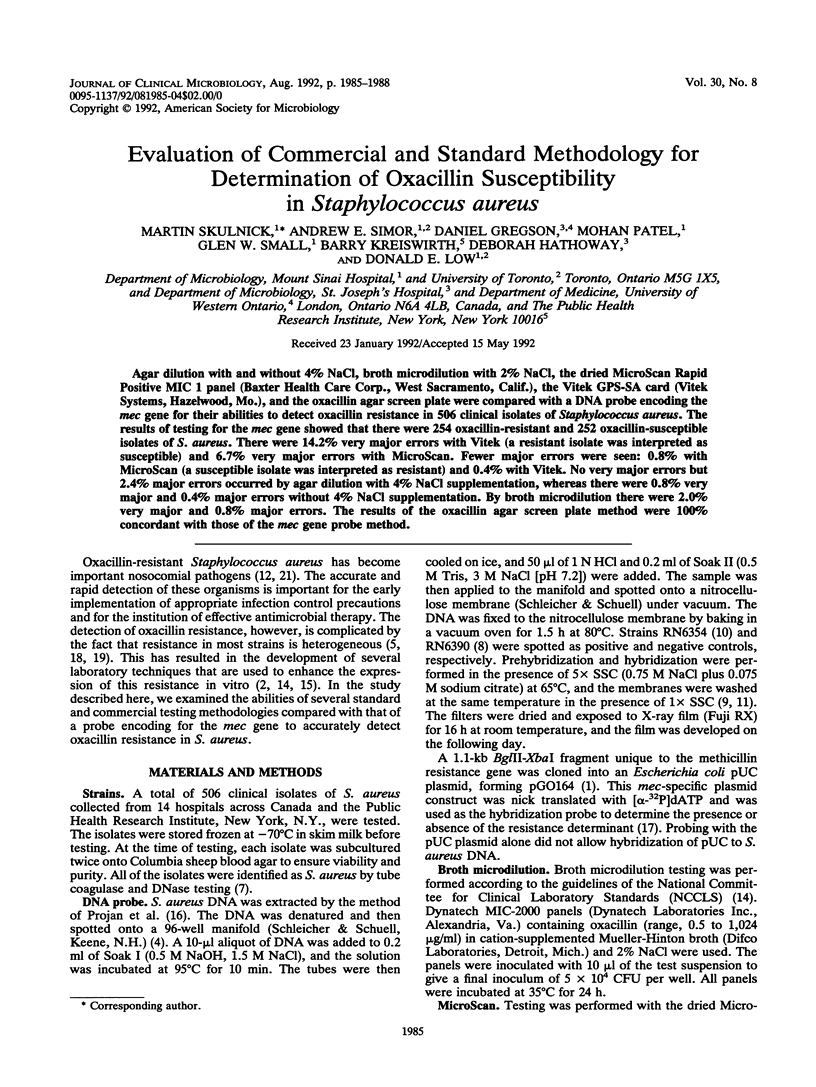Abstract
Agar dilution with and without 4% NaCl, broth microdilution with 2% NaCl, the dried MicroScan Rapid Positive MIC 1 panel (Baxter Health Care Corp., West Sacramento, Calif.), the Vitek GPS-SA card (Vitek Systems, Hazelwood, Mo.), and the oxacillin agar screen plate were compared with a DNA probe encoding the mec gene for their abilities to detect oxacillin resistance in 506 clinical isolates of Staphylococcus aureus. The results of testing for the mec gene showed that there were 254 oxacillin-resistant and 252 oxacillin-susceptible isolates of S. aureus. There were 14.2% very major errors with Vitek (a resistant isolate was interpreted as susceptible) and 6.7% very major errors with MicroScan. Fewer major errors were seen: 0.8% with MicroScan (a susceptible isolate was interpreted as resistant) and 0.4% with Vitek. No very major errors but 2.4% major errors occurred by agar dilution with 4% NaCl supplementation, whereas there were 0.8% very major and 0.4% major errors without 4% NaCl supplementation. By broth microdilution there were 2.0% very major and 0.8% major errors. The results of the oxacillin agar screen plate method were 100% concordant with those of the mec gene probe method.
Full text
PDF



Selected References
These references are in PubMed. This may not be the complete list of references from this article.
- Archer G. L., Pennell E. Detection of methicillin resistance in staphylococci by using a DNA probe. Antimicrob Agents Chemother. 1990 Sep;34(9):1720–1724. doi: 10.1128/aac.34.9.1720. [DOI] [PMC free article] [PubMed] [Google Scholar]
- Chambers H. F. Methicillin-resistant staphylococci. Clin Microbiol Rev. 1988 Apr;1(2):173–186. doi: 10.1128/cmr.1.2.173. [DOI] [PMC free article] [PubMed] [Google Scholar]
- Dickgiesser N., Kreiswirth B. N. Determination of aminoglycoside resistance in Staphylococcus aureus by DNA hybridization. Antimicrob Agents Chemother. 1986 May;29(5):930–932. doi: 10.1128/aac.29.5.930. [DOI] [PMC free article] [PubMed] [Google Scholar]
- Hackbarth C. J., Chambers H. F. Methicillin-resistant staphylococci: genetics and mechanisms of resistance. Antimicrob Agents Chemother. 1989 Jul;33(7):991–994. doi: 10.1128/aac.33.7.991. [DOI] [PMC free article] [PubMed] [Google Scholar]
- Hindler J. A., Warner N. L. Effect of source of Mueller-Hinton agar on detection of oxacillin resistance in Staphylococcus aureus using a screening methodology. J Clin Microbiol. 1987 Apr;25(4):734–735. doi: 10.1128/jcm.25.4.734-735.1987. [DOI] [PMC free article] [PubMed] [Google Scholar]
- Kreiswirth B. N., Löfdahl S., Betley M. J., O'Reilly M., Schlievert P. M., Bergdoll M. S., Novick R. P. The toxic shock syndrome exotoxin structural gene is not detectably transmitted by a prophage. Nature. 1983 Oct 20;305(5936):709–712. doi: 10.1038/305709a0. [DOI] [PubMed] [Google Scholar]
- Kreiswirth B. N., Projan S. J., Schlievert P. M., Novick R. P. Toxic shock syndrome toxin 1 is encoded by a variable genetic element. Rev Infect Dis. 1989 Jan-Feb;11 (Suppl 1):S83–S89. doi: 10.1093/clinids/11.supplement_1.s83. [DOI] [PubMed] [Google Scholar]
- Maple P. A., Hamilton-Miller J. M., Brumfitt W. World-wide antibiotic resistance in methicillin-resistant Staphylococcus aureus. Lancet. 1989 Mar 11;1(8637):537–540. doi: 10.1016/s0140-6736(89)90076-7. [DOI] [PubMed] [Google Scholar]
- Murakami K., Minamide W., Wada K., Nakamura E., Teraoka H., Watanabe S. Identification of methicillin-resistant strains of staphylococci by polymerase chain reaction. J Clin Microbiol. 1991 Oct;29(10):2240–2244. doi: 10.1128/jcm.29.10.2240-2244.1991. [DOI] [PMC free article] [PubMed] [Google Scholar]
- Projan S. J., Carleton S., Novick R. P. Determination of plasmid copy number by fluorescence densitometry. Plasmid. 1983 Mar;9(2):182–190. doi: 10.1016/0147-619x(83)90019-7. [DOI] [PubMed] [Google Scholar]
- Rigby P. W., Dieckmann M., Rhodes C., Berg P. Labeling deoxyribonucleic acid to high specific activity in vitro by nick translation with DNA polymerase I. J Mol Biol. 1977 Jun 15;113(1):237–251. doi: 10.1016/0022-2836(77)90052-3. [DOI] [PubMed] [Google Scholar]
- Ryffel C., Kayser F. H., Berger-Bächi B. Correlation between regulation of mecA transcription and expression of methicillin resistance in staphylococci. Antimicrob Agents Chemother. 1992 Jan;36(1):25–31. doi: 10.1128/aac.36.1.25. [DOI] [PMC free article] [PubMed] [Google Scholar]
- Tokue Y., Shoji S., Satoh K., Watanabe A., Motomiya M. Comparison of a polymerase chain reaction assay and a conventional microbiologic method for detection of methicillin-resistant Staphylococcus aureus. Antimicrob Agents Chemother. 1992 Jan;36(1):6–9. doi: 10.1128/aac.36.1.6. [DOI] [PMC free article] [PubMed] [Google Scholar]
- Townsend D. E., Ashdown N., Bolton S., Bradley J., Duckworth G., Moorhouse E. C., Grubb W. B. The international spread of methicillin-resistant Staphylococcus aureus. J Hosp Infect. 1987 Jan;9(1):60–71. doi: 10.1016/0195-6701(87)90097-1. [DOI] [PubMed] [Google Scholar]


